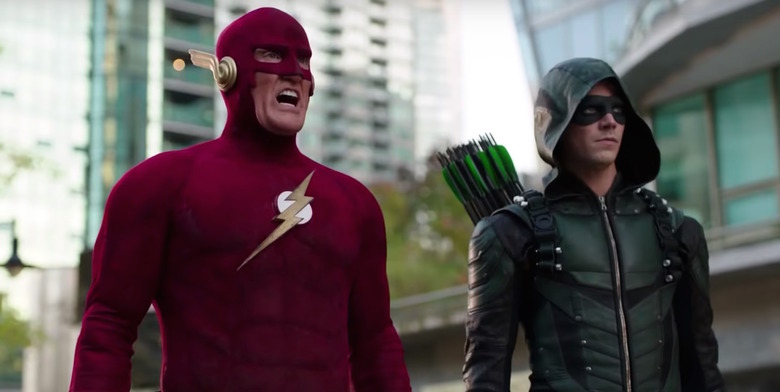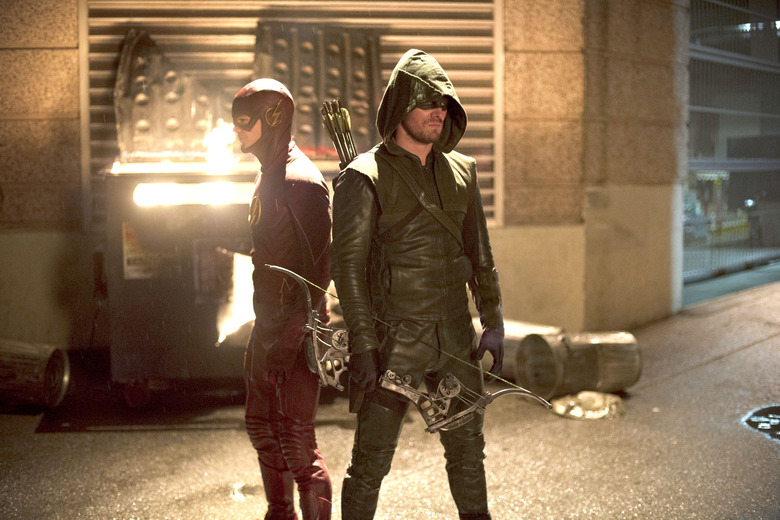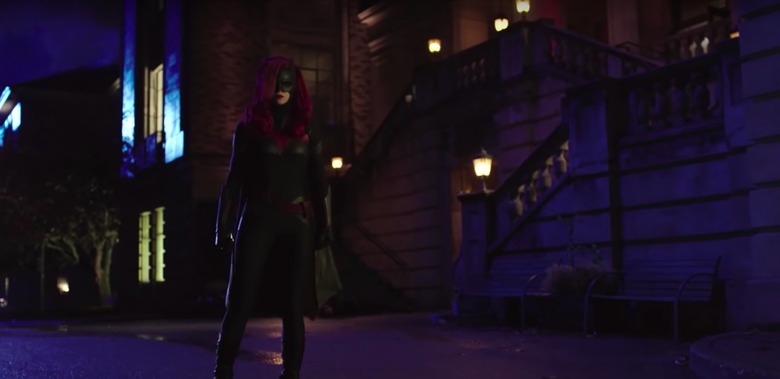The CW's 'Elseworlds' Is An Epic Superhero Crossover Done Right
At the end of this week's Elseworlds, the three-part event unfolding across The Flash, Arrow and Supergirl, The CW's crossover continuity teased a major event straight out of DC comics. It's been hinted at ever since The Flash debuted in 2014 and now it's official: the 1985-86 landmark Crisis on Infinite Earths will finally make its way to screens in the Fall of 2019. What's more, everything these shows have been doing for the last few years, including and especially this recent event, justifies it in spades.
The great thing about these crossover episodes is that each entry feels, at once, like a core part of the weekly event as well as a new chapter in its own series. Take the three-night Invasion! crossover from 2016, which saw the alien Dominators attacking the Earth and all our heroes fighting back. The 100th episode of Arrow played out during the event, and despite the larger, apocalyptic goings on, it found a way to slow things down and zero in on the characters, keeping the Arrow cast in stasis and making them live out a collective, alien-induced dream world that helped define each character's core.
Last year's Crisis on Earth-X felt similar, sending heroes from all four shows (including Legends of Tomorrow, which sat this year's crossover out) tumbling through a world where Nazis won World War II and each of their doppelgangers were part of a modern Third Reich. Each episode focused on a different set of characters, all while setting up DC's animated series The Ray; backdoor pilots are a regular feature of these things. These crossovers manage to do quite a lot, and with the introduction of Ruby Rose's Batwoman (among others), this year's does even more.
The Premise
As suggested by the title, shared with the comics' alt-universe line of stories, Elseworlds involves everything from a multiverse-hopping omniscient entity, to The Flash (Barry Allen) and Green Arrow (Oliver Queen) swapping lives, to a trip through a garish Gotham City, to Lois Lane wielding some sort of cosmic hammer. The pieces all fit together, even if the middle portion (Arrow) is a little lackluster. As much as these events are "for the fans" (there are entire hallways full of Easter eggs) they get why the fans keep coming back. Duet, the Supergirl/Flash musical crossover, was a direct response to viewers noticing how many "Arrowverse" actors could sing, and so it was brought together by meta-entity The Music Meister, who shared our all-knowing perspective on the fictional world. Elseworlds is similar in that regard, in that the being who sets the events in motion (LaMonica Garrett's Mar Novu/The Monitor) knows everyone's identity, just as we do, and wants to prepare them for an even bigger crossover.
Where all the naked fan-service succeeds, however, is the outcome of these whacky happenings. Its "wouldn't-it-be-fun" premise of The Flash and Green Arrow swapping lives brings with it the requisite humour — cheery Grant Gustin becomes a hooded vigilante while mopey Stephen Amell zips around with a smile — but it roots the madness of this body-swap in an investigation of character. The Flash's abilities are rooted in fun and enjoyment, something Amell's Oliver Queen needs to let himself experience for once before walking in Barry shoes, while Barry needs to tap in to all the darkness and tragedy and, essentially, embody them before becoming The Green Arrow. Since Barry and Oliver are the only two people on Earth-1 aware of the major switch, they not only have to dig deep into those parts of themselves they regularly close off, but have to dig into how the other one ticks on a fundamental level. They've been crossing over into each other's shows for four years now, but Elseworlds allows them to fully understand each other's disposition (and in the process, each show's tone) as they try to find out who's re-writing reality.
The answer, unbeknownst to them, is Arkham Asylum's John Deegan, a role tailor-made for the eccentric Jeremy Davies (Lost). He's given The Book of Destiny by Novu/The Monitor and told to change things at will, so all the seemingly random, fan-service-oriented results are essentially just that: the fantasies of a giddy mad-man made real, like some preening fanboy given sudden ownership over the whole continuity. What Deegan doesn't know, however, is the reason he's been giving this power, something our heroes slowly discover over the course of the crossover.
The Structure
Two of three shows involved swapped air-dates in order to accommodate Elseworlds. While Arrow stood its ground on Monday, Tuesday's The Flash switched with Sunday's Supergirl to make sure things went smoothly. Starting with The Flash allowed for the team at S.T.A.R. labs to try and figure out what was wrong — both with Barry and Oliver's Freaky Friday and with the strange red lightning following them — but it also allowed the relationship between Barry and Iris to become a grounding point for the saga. They're in the best place they've ever been as a couple, all things considered (i.e. a daughter who just time-traveled from the future to visit them) while things between Oliver and Felicity, who took center stage in the second episode, aren't quite so peachy.
In order to avoid repeating the happenings of The Flash, Oliver opts not to let Felicity in on the weirdness to spare her the trouble, though in typical Arrow fashion his dishonesty ends up backfiring. If nothing else, the episode placement helps mirror the two shows even further, and establish what's at stake for Barry and Oliver. You know, other than all the destruction caused by super-robot Amazo, which they manage stop with the help of Superman and Supergirl.
The second episode also takes our heroes to Gotham City. With the help of Supergirl/Kara Danvers, and after a brief stop on her Earth's Smallvile (with the requisite throwbacks), the trio heads to Batman's city and to the epicenter of the changes. While the people around them still have a hard time telling Barry from Oliver, Kara, being from another universe altogether, is the only one who knows the truth. This middle chapter being an Arrow episode allows for another reflecting point; the show has often been accused of being a mere riff on Batman, but Star City is a haven compared to the Arrowverse's Gotham.
More Joel Schumacher's sprawling neon-light district than Nolan's grounded Chicago, this Gotham — shot almost entirely with short lenses to exaggerate the gothic architecture — is on the verge of constant implosion and criminal takeover. Not only that, Bruce Wayne has abandoned it. His cousin, Kate Kane (Ruby Rose) is its new overseer, trying to rejuvenate its real estate by day and fighting criminals as Batwoman by night. She guides and observes our trio from afar, as they make their way to Arkham; all hell breaks loose, including the spreading of one of the Scarecrow's fear toxins, and while this has all sorts of potential, it's also Elseworld's first major misstep. The crossover wants desperately to be a point of introspection, something it mostly succeeds at, but it drops the ball in a confounding way during its second episode.
While it can be chalked up to some body-swapping weirdness, Barry Allen, as the Green Arrow, hallucinates Arrow's nemesis Malcom Merlyn, while Oliver's Flash hallucinates the Reverse Flash. They fight each other, as superhero duos are wont to do when under these sorts of effects, but it's a limp and lifeless battle. The Barry we know has no emotional connection to Merlyn, just as Oliver is barely connected to Thawne.
Not only does this feel off from a character standpoint, it looks off from an objective vantage as seen by the characters around them. Barry, now an archer, thinks he's fighting an archer. Oliver, a speedster, thinks he's fighting a speedster, while the reality is speedsters versus archer. None of the battles we're watching unfold — Barry's with Merlyn, Oli's with Thawne, and the "real" one with other — seem to line up, but more importantly, they don't line up from an emotional standpoint. A simple swap between who they're hallucinating would not only have made more logistical sense, but it could have imbued this fight with more passion, as each man sees their ally as their long-time nemesis, putting them in greater danger.
Still, it doesn't quite kneecap the episode (one already bogged down by dour Arrow-esque monologues) but it does leave the middle section wanting. The third chapter however, in which Deegan re-writes reality further, is an all-out blast. He takes on the mantle of a black-clad Superman and reshapes the world in his image, throwing Kara behind bars (where she has to show this world's fascist Alex Danvers the love she's capable of) and turning Barry and Oliver into this world's version of the DC Trigger Twins. De-powered and on the run, they have no choice but to use their wits to outsmart their adversaries, though the eventual help of Superman, Braniac-5 and Martian Manhunter certainly comes in handy. The result is one of the most fun, joyful and meaningful entries in DC's live-action canon.
The Newcomers
Elseworlds is a story of the established crew responding to unprecedented new players; in that regard, it succeeds and fails in equal measure. In the weeks leading up to the crossover, the shows teased the happenings on Earth-90, in which John Wesley Shipp returned as his Barry Allen from the 1990 The Flash TV show. Bodies lay strewn about — some, seemingly of heroes from Smallville — as these other DC continuities were seemingly made canon as The Monitor's book wreaked havoc. Shipp's Barry eventually made his way to Earth-1 to fight alongside our heroes, but he (and in the process, his dying world) were quickly brushed aside and returned to their seemingly rightful margins. A disappointment to be sure, not only because Shipp is always a delightful addition, but because the question of how to help this other Earth in peril never crosses our heroes' minds. (These are, mind you, superpowered beings with the ability to universe-hop at will)
The only other disappointment, and an unfortunate one at that, is Ruby Rose's Batwoman. While her civilian identity makes for a fantastic grounding point in this Gotham — if her show takes off and Kate Kane is tasked with fixing a world gone mad, I'm here for it — but the introduction of her Batwoman creates little intrigue. Her suit, while fantastic to look at in live-action, has the age-old Batman problem of stiffening movement. There's little separating Kane from her "darker" persona at this stage, though with the limited screen time afforded to Rose, that's hardly the fault of the actor.
On the plus side, the biggest newcomer here is LaMonica Garret. While he may not show up for another year, this is by no means the last we've seen of him. His Mar Novu/The Monitor carries himself like your average comicbook megalomaniac, however to call him a sympathetic villain doesn't really do him justice. While the crossover teases future villain villains Psycho Pirate and Doctor Destiny, The Monitor falls right in between the extremes of hero and villain — more burdened anti-hero than genocidal killer — while also acting as a nexus to signal where this universe has been and where it's headed.
The Monitor speaks of a greater threat, all that it took from him and all that it's going to take once DC's many universes begin to collide. We catch a few glimpses of what this looks like as John Deegan, in the visage of Tyler Hoechlin's Superman, rewrites reality over and over, but it's also going to mean all the Earths we've seen so far colliding at some point. Novu's reason for throwing these worlds into turmoil is testing its heroes, something he admits with a certain weight behind his eyes. A God-like being, he's seen everyone and everything in this multiverse, including pain, and he seems to be the only one who can prepare our heroes for what's about to happen. Like the audience, this meta-character wants The Flash, Green Arrow, Supergirl et al to be ready for the biggest, most mind-blowing DC event next year. What role he plays when it comes around will be interesting to see.
But of course, no conversation about newcomers is complete without Elizabeth Tulloch's Lois Lane. She and Clark are staples of this world by this point, character's who've been through it all and are ready to pass the responsibilities of heroism on to Kara. With just a few looks and few stray lines, Tulloch crafts a new character who feels like she's been around for ages. She's a feisty foil to Superman's calm, and a self-assured woman unafraid to jump into the thick of it. While there'll never be a pairing as definitive as Christopher Reeve and Margot Kidder, Hoechlin and Tulloch are easily the actors who have come the closest, that too with the least amount of shared screen time.
It also helps that they pretty much embody Lois and Clark in every way:
I shot my #Elseworlds #LoisLane scenes btwn 23-26 weeks pregnant so they didn't want me to do stunts. Here are photos of the rig they made for me when Lois is falling so I wouldn't have to be harnessed. Sweet Tyler noticed my neck at an awkward angle & came over to support me. ❤️ pic.twitter.com/OaryI8icyf
— Elizabeth Tulloch (@BitsieTulloch) December 12, 2018
A fitting note to end the year on, as we look forward to CW's DC shows continuing to capture what makes the comics wonderful. I thought it would be a cold day in hell when we got to see Crisis on Infinite Earths on screen. However things, it seems, are looking bright in the buildup to Fall 2019.



